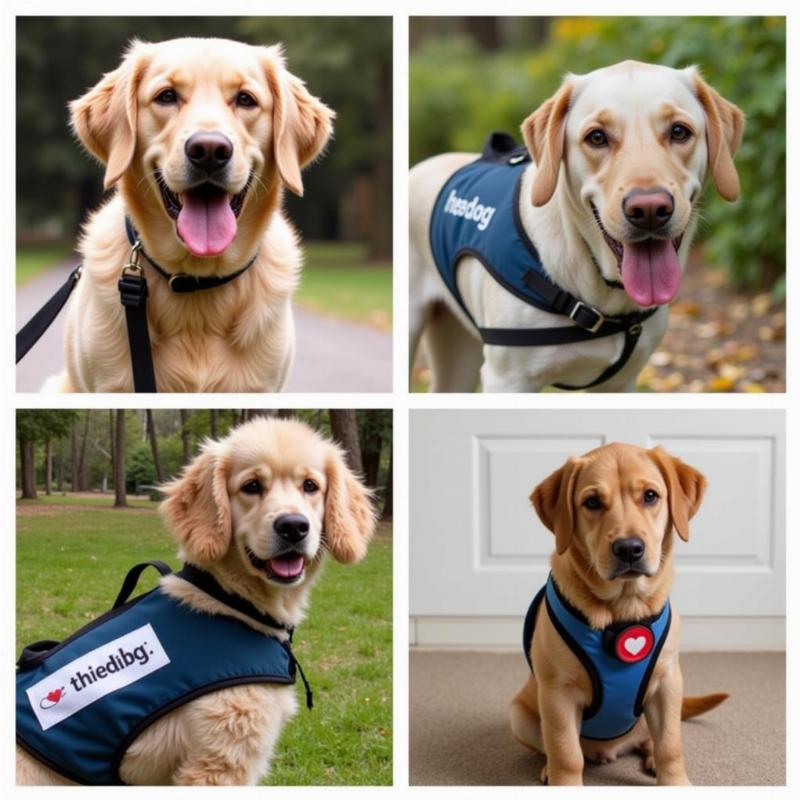Therapy dogs bring comfort, joy, and healing to people of all ages and backgrounds across the United States. Love on a leash represents more than just a heartwarming image; it symbolizes the profound impact these specially trained canines have on improving lives and fostering emotional well-being. Whether visiting hospitals, schools, or nursing homes, therapy dogs offer a unique form of unconditional love and support. This article explores the world of therapy dog programs, highlighting their benefits, the requirements for certification, and how you can get involved with your furry companion.
Understanding the Role of a Therapy Dog
What exactly is a therapy dog? It’s a dog trained to provide comfort and affection to people in various settings, such as hospitals, nursing homes, schools, and even disaster areas. Unlike service dogs, who are trained to perform specific tasks for individuals with disabilities, therapy dogs focus on providing emotional support and companionship. They are carefully selected for their temperament, obedience, and ability to interact calmly with diverse groups of people. Their presence can reduce stress, lower blood pressure, and even encourage communication and social interaction.
The Benefits of Therapy Dog Visits
The positive impact of therapy dogs is well-documented. Studies have shown that interacting with therapy dogs can reduce anxiety and depression, improve cardiovascular health, and even lessen the perception of pain. In children, therapy dogs can promote literacy and social skills, while in the elderly, they can combat loneliness and improve overall mood. For individuals facing challenging life circumstances, the unconditional love and acceptance of a therapy dog can be a powerful source of comfort and strength.
Becoming a Therapy Dog Team: Requirements and Certifications
If you’re interested in sharing the love of your dog with others, becoming a therapy dog team is a rewarding experience. The first step is to assess your dog’s temperament. Is your dog friendly, patient, and comfortable around strangers and different environments? Obedience training is essential, as therapy dogs must be well-behaved and respond reliably to commands. Several reputable organizations offer therapy dog certifications in the U.S., including the Alliance of Therapy Dogs and Therapy Dogs International. These organizations typically require evaluations to assess the dog’s suitability and the handler’s ability to control and manage their dog in various situations.
Finding Therapy Dog Opportunities Near You
Once your dog is certified, numerous opportunities exist to volunteer as a therapy dog team. Contact local hospitals, nursing homes, schools, and libraries to inquire about their therapy dog programs. Many organizations welcome the support of therapy dog teams to enhance the well-being of their clients and students. You can also connect with therapy dog organizations in your area for information on volunteer opportunities and resources.
Choosing the Right Breed for Therapy Work
While any breed can potentially become a therapy dog, some breeds are particularly well-suited for this role due to their temperament and characteristics. Golden Retrievers, Labrador Retrievers, and Poodles are known for their gentle nature and trainability. However, it’s crucial to remember that each dog is an individual, and temperament is more important than breed. tplo surgery for dogs recovery provides insights on dog surgery recovery which is vital information for any dog owner.
 Various therapy dog breeds
Various therapy dog breeds
Conclusion
Love on a leash truly encapsulates the power of therapy dogs to make a difference in people’s lives. These remarkable animals offer a unique form of healing and companionship, bringing comfort and joy to those in need. By understanding the requirements, benefits, and opportunities associated with therapy dog programs, you can explore the possibility of sharing the love of your dog with others and experience the profound rewards of this special bond. cute puppy dog coloring pages for adults offer a relaxing activity that can be enjoyed with your canine companion.
FAQ
- How do I find a certified therapy dog evaluator near me? Contact reputable organizations like the Alliance of Therapy Dogs or Therapy Dogs International for a list of certified evaluators in your area.
- What is the difference between a therapy dog and a service dog? Therapy dogs provide emotional support and comfort, while service dogs are trained to perform specific tasks for individuals with disabilities. what are the first signs of internal bleeding in dogs provides crucial information for dog owners about a serious medical condition.
- Are there specific age requirements for therapy dogs? While there isn’t a strict age limit, dogs should be mature enough to handle the demands of therapy work and have a calm and predictable temperament.
- Can mixed breed dogs become therapy dogs? Absolutely! Temperament and training are the key factors, not breed.
- How often do therapy dogs need to be re-certified? Recertification requirements vary depending on the organization, but it’s typically an annual process.
- What kind of training is required for therapy dogs? Basic obedience training is essential, along with specialized training to ensure the dog is comfortable and well-behaved in various therapy settings. tax collector’s dog crossword can be a fun way to learn more about dog breeds.
- Is there a cost associated with therapy dog certification? Yes, there are usually fees associated with evaluations and certifications. Contact the specific organization for details.
Beautdogs.us is your premier source for comprehensive and reliable information on dog care, breeds, and products in the USA. We offer expert advice, valuable resources, and a passionate community dedicated to celebrating the joys of dog ownership. Whether you’re a new dog parent or a seasoned expert, Beautdogs.us is your trusted companion on your dog-owning journey. Contact us today for personalized support and guidance! Email: [email protected], Phone: +1 501-555-7529. before and after fho surgery dog showcases the positive impact of this surgical procedure on dogs.